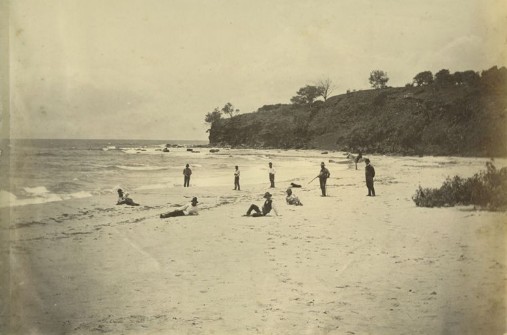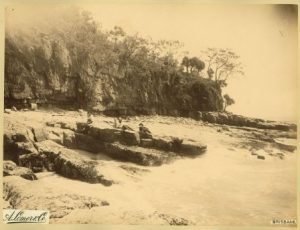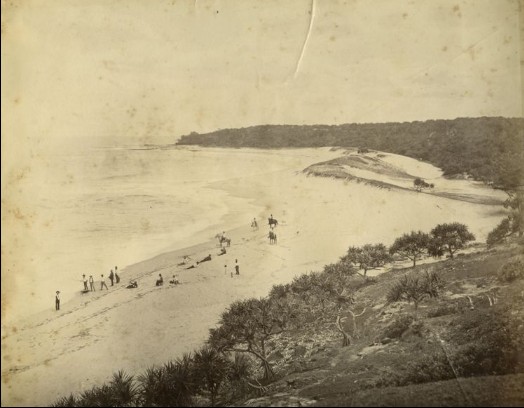One of the earliest photos of Shelly and Moffat Beach, taken in the late 1800s, has raised the mystery as to why men were on the sand with guns and horses, and how they got there.
The images, which are believed to have been taken around 1885, have a recent caption describing the group as “enjoying a day” at “Shelley Beach” or “enjoying the seashore”.
The men (and a dog) are scattered across the broad and isolated stretch of sand framed by pandanus trees, and are posed either standing or lounging sideways.
Many of them are turned in the direction of the photographer, A. Lomer, who would have been positioned with his camera on the hill towards what is today Moffat Headland.
It’s an idyllic scene from a era before coastal development when Caloundra was barely inhabited and the shoreline was virtually untouched.

But a historian from Sunshine Coast Libraries’ heritage section said it was unlikely the fully-clothed men were having a relaxing day by the sea in the way we would imagine it today.
One clue is that one of the men at Moffat Beach is holding a rifle and four of the group at Shelly Beach are on horseback.
But also, getting to Caloundra at that time was not easy because the hinterland railway line would not be developed for another five years or so in the 1890s.
When these photos were taken, rivers were the lifeblood of travel and business in Queensland because that’s how the pioneers made their money.
Can you shed any light on the beach mystery? Email us via news@sunshinecoastnews.com.au
It was also easier to reach places by sea (and sunken ships were not infrequent occurrences).
To embark on a land journey to Caloundra in the late 1800s would have involved travelling by horse and cart on rudimentary dirt roads.
The main thoroughfare from Brisbane to the north coast region was Gympie Road but it did not extend from the rural township of Landsborough to the beaches.
To traverse the hilly distance from Landsborough to Caloundra’s quiet sands would have required braving the overland tracks with horse and dray.
It certainly was not a case of putting on a hat and skipping down to the sea to spend a relaxing day in the sun with the boys.

The man who captured these images was Albert Lomer, a well-known photographer from Brisbane, whose collection included a similar shot at Moffat Beach and a later one at Noosa Heads around 1889.
Mr Lomer was one of the pioneers during the birth of photography in Brisbane which flourished between the 1850s through to the early 1900s.
Love nostalgia? So do we. Help keep more great Coast memories alive by subscribing to our free daily news feed. Go to Subscribe at the top of this story and add your name and email. It’s that simple.
His Shelly Beach image has been dated to around 1885, which is a couple of years after the first public land sales were released at Caloundra in 1883.
At that time the region was a still a largely unsettled rugged expanse that had piqued the interest of the Brisbane press a couple of decades earlier in 1863 when the Queen of Colonies ship sank off Moffat, making its survivors the first involuntary white residents.
In 1870, Charles Ballinger had become the first landholder with land at the present day Hibiscus Family Holiday Park on the shore of the Pumicestone Passage, but he never lived there.
A new deed was issued in 1875 to Robert Bulcock who built the first house, but he too was not a permanent resident.
The first true European resident is said to be Thomas John Ballinger, the son of Charles, who selected land south of Lake Currimundi and built a slab hut by the beach in 1881.
His land known as Ballinger’s Hill is now known as Battery Hill.

The second resident in Caloundra was Samuel Leach, who owned land at the junction of Pumicetone Passage and Bell’s Creek, the southern extreme of Caloundra. Leach Park is named after him.
Years later in 1886, around the time A.Lomer’s photo was taken, Caloundra’s first hotel was established at Shelly Beach by Anthony Alder, a taxidermist who had a short stint as a hotel licensee.
It was known as Caloundra Hotel and was located on Victoria Terrace.
From the late 1800s to the early 1900s, Caloundra’s first shops and services began to open as land sales picked up.
But it was not until after after World War II that the town began to grow rapidly and become a popular holiday destination where people sought time on the sand in the way we do today.





